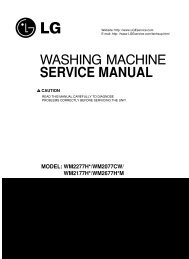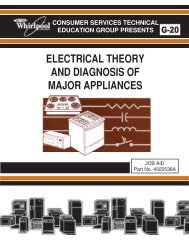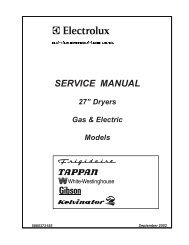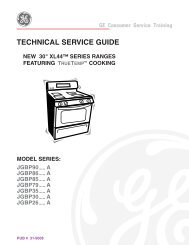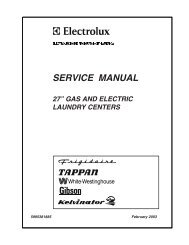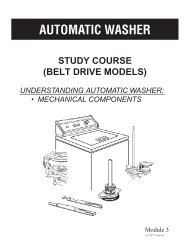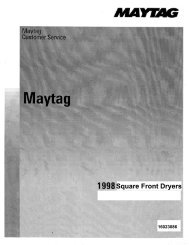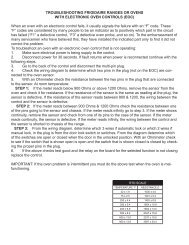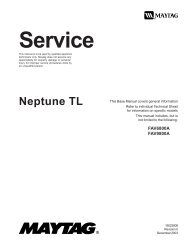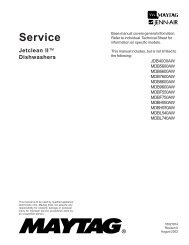MFI2568AES Service Manual - Appliance 911 Sea Breeze
MFI2568AES Service Manual - Appliance 911 Sea Breeze
MFI2568AES Service Manual - Appliance 911 Sea Breeze
You also want an ePaper? Increase the reach of your titles
YUMPU automatically turns print PDFs into web optimized ePapers that Google loves.
Component Testing<br />
! WARNING<br />
To avoid risk of electrical shock, personal injury, or death, disconnect electrical power source to unit, unless test<br />
procedures require power to be connected. Discharge capacitor through a resistor before attempting to service.<br />
Ensure all ground wires are connected before certifying unit as repaired and/or operational.<br />
Component Description Test Procedures<br />
Drier<br />
Drier is placed at post condenser loop<br />
outlet and passes liquified refrigerant to<br />
capillary.<br />
Desiccant (20) 8 x 12 4AXH - 7 M>S> -<br />
Grams<br />
Drier must be changed every time the system is opened for testing or<br />
compressor replacement.<br />
NOTE: Drier used in R12 sealed system is not interchangeable with<br />
drier used in R134a sealed system. Always replace drier in R134a<br />
system with Amana part number B2150504.<br />
Before opening refrigeration system, recover HFC134a refrigerant for safe<br />
disposal.<br />
1. Cut drier out of system using the following procedure. Do not unbraze drier.<br />
2. Applying heat to remove drier will drive moisture into the system.<br />
3. Score capillary tube close to drier and break.<br />
4. Reform inlet tube to drier allowing enough space for large tube cutter.<br />
5. Cut circumference of drier 1 ¼" below condenser inlet tube joint to drier.<br />
6. Remove drier.<br />
7. Apply heat trap paste on post condenser tubes to protect grommets from high<br />
heat.<br />
8. Unbraze remaining part of drier. Remove drier from system.<br />
9. Discard drier in safe place. Do not leave drier with customer. If refrigerator is<br />
under warranty, old drier must accompany warranty claim.<br />
!<br />
WARNING<br />
To avoid death or severe personal injury, cut drier at correct location.<br />
Cutting drier at incorrect location will allow desiccant beads to scatter. If<br />
spilled, completely clean area of beads.<br />
Evaporator<br />
Inner volume of evaporator allows liquid<br />
refrigerant discharged from capillary to<br />
expand into refrigerant gas.<br />
Test for leaks in evaporator with electronic leak detector or with soap solution.<br />
Compressor oil is circulated with refrigerant; check for oil when checking for<br />
leaks.<br />
Expansion cools evaporator tube and fin<br />
temperature to approximately -20°F<br />
transferring heat from freezer section to<br />
refrigerant.<br />
Passing through suction line to<br />
compressor, the refrigerant picks up<br />
superheat (a relationship between<br />
pressure and temperature that assures<br />
complete vaporization of liquid<br />
refrigerant) as the result of capillary tube<br />
soldered to suction line.<br />
Refrigerant gas is pulled through suction<br />
line by compressor, completing<br />
refrigeration cycle.<br />
For minute leaks<br />
1. Separate evaporator from rest of refrigeration system and pressurize<br />
evaporator up to a maximum of 140 PSI with a refrigerant and dry nitrogen<br />
combination.<br />
2. Recheck for leaks.<br />
!<br />
WARNING<br />
To avoid severe personal injury or death from sudden eruption of high<br />
pressures gases, observe the following:<br />
Protect against a sudden eruption if high pressures are required for leak<br />
checking.<br />
Do not use high pressure compressed gases in refrigeration systems<br />
without a reliable pressure regulator and pressure relief valve in the<br />
lines.<br />
Thermostat<br />
(defrost)<br />
Thermostat is in a series circuit with<br />
terminal main control board and defrost<br />
heater.<br />
Controls the circuit from main control<br />
board through defrost thermostat to<br />
defrost heater. Opens and breaks circuit<br />
when thermostat senses preset high<br />
temperature.<br />
Test continuity across terminals.<br />
With power off and evaporator coil below freezing, thermostat should show “0”<br />
ohms when checked with ohmmeter. See “Heater, evaporator (defrost)” section<br />
for additional tests. If evaporator coil is warm, should show 56k ohms with an ohm<br />
meter.<br />
After defrost thermostat opens, thermostat remains open until end of defrost cycle<br />
and refrigerator starts cooling again. Defrost thermostat senses a preset low<br />
temperature and resets (closes).<br />
8 16026312 ©2006 Maytag <strong>Service</strong>s



